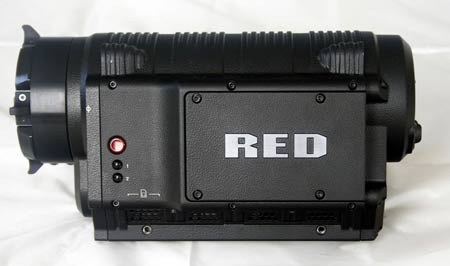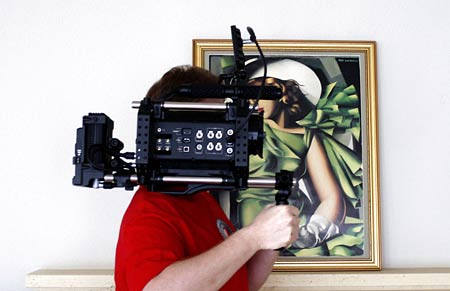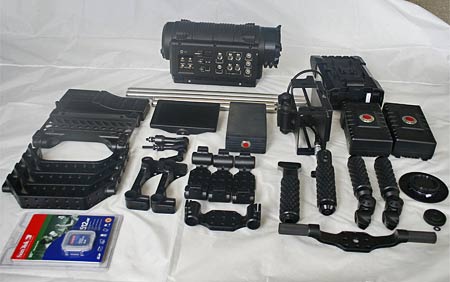4K RED One Camera - Unwrapping The Lamborghini Of Video Cameras
Mountain House (CA) - The story of RED reminds me of a story from the automotive industry. Back in 1963, Ferruccio Lamborghini complained to Enzo Ferrari about the quality of the clutch on his Ferrari 250 GT, and Enzo angrily answered: "You build tractors. How can you know how to manufacture a sports car?". Then, Ferruccio decided to beat Il Commendatore in his own game, and the tractor manufacturer turned into a company that builds fantastic sports cars.
Jim Jannard, founder and CEO of Oakley, known for its sun glasses, wanted a compact and durable HD camera. Oakley is well-known for its relationship with sports, so this wish was not too surprising. Jim's idea did not find any friends at broadcast equipment manufacturers such as Sony, Canon and JVC.
Left with his idea, Jim founded RED Digital Camera, a company that aimed to create a high-resolution "Beyond HD" camera that can capture the fast pacing world of sports - in an affordable way.
The first product, RED One, does not yet achieve this goal, but is an indication of what we can expect to see from this company in the future. The compact and durable HD camera should come with the upcoming debut of RED Scarlet, a "pocket-sized" professional digital video camera. (More details about the Scarlet will be released at this year's NAB convention in Las Vegas - lectures starting on Friday, April 11th.)
In this story, we will focus on the experience of assembling RED One, one of the most fascinating video cameras you can buy today.
What's all the fuss about?
If you are wondering what is so revolutionary about RED, and why Peter Jackson and Steven Soderbergh can't imagine their life without this camera, there's a fairly simple reason for that: This is the first digital video camera that has a resolution that exceeds 35 mm film, while the dynamic range is coming very close to traditional cameras. At its core, the camera uses a Mysterium CMOS sensor: The physical resolution of this monster is 4900 x 2580 pixels, for a total of 12.64 million pixels. The sensor measures in 24.4 x 13.7 mm (334 mm2).
Depending on your point of view, the camera also does not cost an arm and a leg. Of course, the camera is not in the same category as average HD handycams that currently sell for less than $1000. You have to remember that the RED One gives you the possibility to become a movie maker. The complete product sells for about $25.000 ($17.500 for the body) and records movies in 4K resolution. As a sidenote, a 4K movie feature is something you otherwise can't get, even if you have $100.000 in the bank.
Some unique features
RED Users will have to get used to RAW workflow, similar to what is done in professional SLR photography. A software interface to access RAW recordings is provided with the firm's RED ALERT! and REDCINE applications. To capture the proprietary Redcode RAW codec and process it with decent results, you need to get used to the RAW workflow, using the supplied software software. Of course, the downside is that the transcoding will take quite some time, but it appears that RED is actually working on some ideas to improve the workflow.
Needless to say, you will need a Ninja PC or a Mac Pro with a ton of memory to go through the transcoding. A Quadro FX SDI card could be your ticket to ride, too.
The results, however, speak for themselves. We had a chance to give the camera a quick test run and found that the camera creates fascinating image quality, given the fact that the Redcode RAW codec actually floats between 215-288 Mb/s.
4K at 30fps or a 2K resolution at 120 fps for slow- and superslow-motion works like a charm, and this is just one of options that come as firmware upgrades. Oh, we forgot to mention, the camera comes with a 512 MB SD card, which is used to upgrade the operating system of the camera.
17 boxes of joy
This camera should be viewed as a sports car. It is a magnificent piece of machinery and that has those very special small things 99% of people don't notice. The driver, however, will notice. You can follow the assembly process picture by picture in our gallery at the end of this article.
RED One is a complete product. There are numerous customization options and you can customize the camera based your needs, not the other way around. In our case, we ordered components necessary for filming from a shoulder and when placed on a tripod.
We learned that the assembly of the kit will take a whole afternoon or about six hours. During the assembly, I often felt like a kid playing around with Lego Technic for the first time, with the difference being that I am much older now and, of course, these building blocks cost mucho dinero.
It is interesting to note that the RED One does not come with any documentation. In fact, the only documentation is a manual about the RED Charger, a sturdy-looking charger that fits two RED Bricks, 14.8V lithium-Ion batteries (9.4 Ah, 140Wh).
Originally, RED shipped us three boxes that contained 13 smaller boxes with all the parts, or, so we thought. Sadly, first shipment did not feature all of the parts, which we discovered during the first assembly of the camera. After talking with a sales rep, the missing components were shipped and we could proceed with the assembly of this setup. Given the number of smaller components, we would advise any RED buyer to check and re-check that everything in fact has arrived and, more importantly, that you ordered everything you need (in our case, we forgot one top mount piece).
We ordered the following components:
- RED One body
- Base Production Pack
- RED LCD
- RED Power Pack (2x Battery + Charger)
- RED Drive (RAID - 2x 2.5" HDD)
- RED Flash Module (Compact Flash reader)
- RED Top Mount (x2)
- RED Right Handle (x2)
- Side Handle (x2)
- RED Rod 12" (x2) , 18" (x2)
- Nikon lens mount
- Universal lens mount
- Cables (LCD, mini-SDI, Power, Drive)
Overall, this configuration put this camera at the same price level as a brand new Honda S2000 convertible. We opted to acquire a Nikon lens mount and will wait for RED Prime, a set of production lenses that is expected to debut soon and will cost an additional $19.000. Overall, the investment in RED gear is going to end up around $50.000 for this camera. While $50,000 may sound steep, bear in mind that this camera yields better results than Sony's professional movie equipment: In fact, we talked to colleagues from a movie production company who claim that RED offers the best value for their money (if you don't need real-time broadcast features).
Assembling the camera proved to be a relatively easy task, if we carefully took take one step at the time and avoided to apply excessive pressure on the screws: By the time you have assembled the camera, you will have changed the position of rods several times. RED provided large number of hex keys, but ended up using only two bolts in the kit: a standard bolt and a "fatty" (for connecting key components, such as the RED Cradle for the battery and the RED Drive and RED Flash).
We spare you all the details of which screw and rod went where, but send you instead to the slide show, which shows you the path from the boxes to the finished product.
Conclusion
After spending better part of Sunday putting the RED camera together, we still wonder ... is RED the Lamborghini or Ferrari of camera world, with the price of a Dodge Viper. And will Sony, Canon, Nikon, JVC and other manufacturers learn something of RED's shining example?
At the end of the day, I have to say that I don't really care. There's a new king in town. In case you are wondering, yes that is actually this author's personal camera and I am intending to use the camera for one or the other project. And, of course, we will update you on what this camera can do as soon as we have to put the RED One to work. Hrvoje, you can put that Sony 1080p HDVCAM aside, this baby is coming home.
{gallery}200804061{/gallery}
Get Tom's Hardware's best news and in-depth reviews, straight to your inbox.




